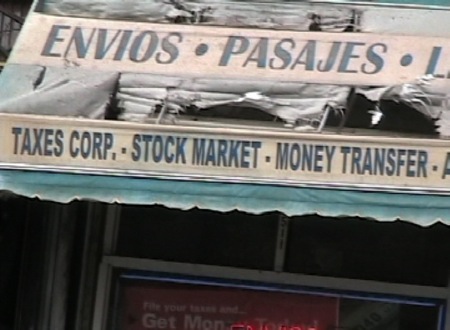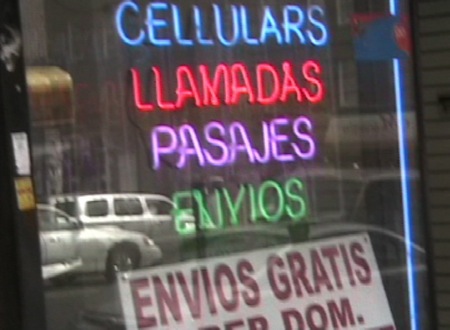Washington Heights: Economy
From Decoding New York
| Introduction |
| Washington Heights |
| * Evolution |
| * Here v. There |
| * What's Real |
| * Economy |
| Rego Park |
| * Evolution |
| * Here v. There |
| * Economy |
| Comparison |
| * Photo Gallery |
| * Sources
Washington Height's economy is centered upon transnationalism. Most businesses in the area are run by immigrants catering to shoppers of their own nationality, or are services for travel, long-distance telephone calling, or mail delivery that help both the local Washington Heights economy and the economies of their home countries.
He notes that there are transnational connections in the field of construction where construction firms in the Dominican Republic depend on returning immigrants from Washington Heights. Therefore, many construction businesses will advertise in Washington Height's newspapers for businesses in foreign countries (Portes 283). "Dominicans are primarily economic immigrants who come to escape difficult conditions at home while maintaining close ties with their families and communities of origin. Over time, Dominican immigration has become incresingly diversified--encompassing professionals as well as rural laborers" (Portes 284).
The Washington Heights that I encountered was an economy all on its own. There were no major chain stores, just individual vendor stands with workers trying to earn money out in the cold. Many small shops were run by members of the local immigrant population themselves. While to me this seemed to have a positive implication because members of the Washington Heights population were embracing and replicating the conditions of their home country, many researchers like Glenda Laws would argue that the Hispanic population in Washington Height's disconnect from the mainstream, corporate economy is a result of globalization, which ultimately has a negative effect upon these groups. She notes that, "globalization has invoked not only new economic geographies but also new social geographies," and believes that this often leads to the increasing polarization between ethnic groups more accepted and incorporated into our coporate economy, and those removed from it (Laws 95). Nancy Foner similarly highlights the economic racial divides which exist between many immigrant populations such as the Dominicans in Washington Heights, and the non-immigrant population. She writes that in 1997, "the Dominican population had the highest poverty rate, 46 percent compared to 24 percent for the entire city... Similarly, per capita household income among Dominicans was substantially lower than the New York City average... The unemployment rate for Dominicans was close to double the rate for the overall New York City Population" (Foner 255). She describes these economic differences as existing in the Washington Heights population for three major reasons; the declining fields in which many Dominicans are employed, the low education rates, and the fact that most Dominican families are run by a female. For example, she notes that many Dominicans are employed in jobs related to "manufacturing and wholesale/retail trades," fields in which competition is on the rise and wages as well as the security of health care and retirement insurance are on the decline. Furthermore, she observes that more than half the incoming Dominican population have not finished highschool, a factor that is tied directly to a decline in income. A final economic handicap which she believes is leading to the increasing polarization between immigrant and non-immigrant groups in Washington Heights is the fact that the majority of Washington Height's Dominican families are female run, leading to a greater need for government aid (Foner 255). Ultimately, the forces of transnationalism, globalization, and racial-societal barriers, all contribute to the shaping of Washington Height's unique, and underground economy. Washington Heights is an example of an ethnic community removed from the norms of New York City's business and culture. While this cultural disconnect is often perceived as having a damaging effect on newly arriving immigrant populations, I observed that the sense of community instilled by localized businesses, and a unified Hispanic culture was a source of pride for many residents of the Washington Height's population who would blast traditional Spanish music and reggaeton from their storefronts, and greet other neighbors welcomingly in an array of Spanish dialects. This section on Washington Heights and Rego Park developed by Irina Mullokandova, Karina Fatova, Quinn Marston. |

